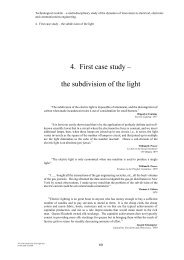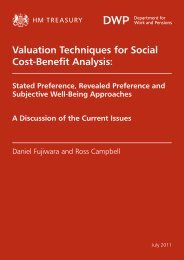Valuing Our Natural Environment Final Report ... - HM Treasury
Valuing Our Natural Environment Final Report ... - HM Treasury
Valuing Our Natural Environment Final Report ... - HM Treasury
You also want an ePaper? Increase the reach of your titles
YUMPU automatically turns print PDFs into web optimized ePapers that Google loves.
<strong>Valuing</strong> <strong>Our</strong> <strong>Natural</strong> <strong>Environment</strong> – <strong>Final</strong> <strong>Report</strong> - Annex1<br />
A1.2.1.7 Principal outputs<br />
The basic outputs of questionnaires and interviews will take the form of proportions of<br />
population responding in a particular way to a particular question. Beyond this, the interest<br />
is primarily in the statistical analysis of responses, in particular (a) explaining response<br />
proportions in terms of demographics and (b) correlating responses across different<br />
questions, for example, linking particular stated behaviours to particular stated attitudes or<br />
values. Usually the results will be written up in the form of a report, which may be ‘glossy’,<br />
and will often make substantial use of graphs, charts, tables and other ways of presenting<br />
the data. This may be combined with other outputs (e.g. focus group results) relating to<br />
the same topic.<br />
A1.2.1.8 Transferability of outputs<br />
Questionnaires will usually produce transferable results if the sample size is adequate and<br />
the sample has been randomly selected to fit a demographic quota. It may even be possible<br />
to transfer to other populations within the same culture by correcting for demographic<br />
differences.<br />
A1.2.1.9 Key uses – decision-making context(s)<br />
The questionnaire approach is suitable for meeting any requirement for basic data on<br />
views, behaviours and so on as well as for research exploring underlying reasons and<br />
correlations. However the approach it is not participatory and can not really be<br />
implemented within a deliberative setting (but the results of surveys might provide<br />
background data for deliberative processes). Therefore questionnaires may be useful either<br />
at an early stage in decision making, or where it is unlikely that full participatory<br />
approaches will be used but there is nevertheless a desire to take citizens' views into<br />
account. Questions can also be directed at estimating policy impacts/effectiveness, for<br />
example trying to find out how respondents might alter their behaviour under a particular<br />
policy (for example, how behaviour might change if an eco-tax were introduced). However,<br />
there is always a problem here going from stated (hypothetical) intentions to actual<br />
responses, and further concern about the potential for strategic responses.<br />
A1.2.1.10 Key uses – coverage of natural environment<br />
Questionnaires can be applied to cover any natural resource or issue. However, where the<br />
resource in question is unfamiliar or poorly understood, or where the issues relate to<br />
complex human-environment interactions where the general public is unlikely to be well<br />
informed or to have considered the issues, there may be limited value in a questionnaire<br />
approach. This is because questionnaire time is expensive, and the level of<br />
attention/patience is likely to be much less than in a group discussion, so there are limits<br />
on the amount of information that can be provided and the amount of thinking time<br />
respondents can be allowed (or will take). Hence the technique is best suited to ‘taking the<br />
pulse’ of existing attitudes on environmental issues and behaviours, rather than engaging<br />
the public in complex reflection on new and challenging topics.<br />
Because of time/attention constraints, there is a limit on the number of questions and<br />
therefore the number/depth of topics covered. One way of reducing this problem can be<br />
to use split sample designs, where different questionnaires are used for each sub-sample,<br />
with some questions in common to all versions. This can give maximum statistical<br />
representativeness for the questions of key interest, while allowing a wider exploration of<br />
secondary issues with lower sample sizes. Careful design is needed in such cases to ensure<br />
that all statistical analyses of interest will be possible with the combinations of survey<br />
version/sub-sample achieved.<br />
A1.2.1.11 Discussion<br />
If done well, questionnaires can produce reliable and statistically significant results.<br />
However, the methodology can be abused. For example, short questionnaires with leading<br />
questions can be used to pad out press releases with ‘information’ of the "8 out of 10 cats<br />
prefer..." variety. Hence the results of surveys should be interpreted with care, in<br />
conjunction with their questions. <strong>Report</strong>ing should always include the exact questions, and<br />
eftec A32<br />
December 2006





![AIRTO [Professor Dr Brian Blunden] - HM Treasury](https://img.yumpu.com/15492848/1/184x260/airto-professor-dr-brian-blunden-hm-treasury.jpg?quality=85)










